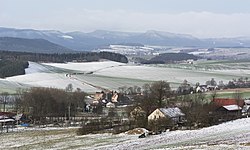Suszyna
Suszyna | |
|---|---|
Village | |
 General view | |
| Coordinates: 50°28′37″N 16°31′23″E / 50.47694°N 16.52306°E | |
| Country | |
| Voivodeship | Lower Silesian |
| County | Kłodzko |
| Gmina | Radków |
| Elevation | 380−415 m (−982 ft) |
| Population | |
• Total | 233 |
Suszyna [suˈʂɨna] (German:Dürrkunzendorf) is a village in the administrative district of Gmina Radków, within Kłodzko County, Lower Silesian Voivodeship, in southwest Poland.[1] Between 1975 and 1998 the village belonged to the Wałbrzych Voivodeship
Geography
[edit]It lies approximately 9 km (6 mi) east of Radków, 11 km (7 mi) north-west of Kłodzko, and 81 km (50 mi) south-west of the regional capital Wrocław. It is a small chain village in the south-eastern part of the Ścinawskie Hills . It lies at an altitude of about 380–415 m above sea level, in a fairly deep valley, through which flows down a small stream. These hills are built of red-spotted slugde with melafir clusters. Suszyna features a variety of minerals and precious stones including amethyst and agate. In one of its hamlets - Mrówieniec (Ger. Finkenhübel b. Seifersdorf) between 1830 and 1840, high quality graphite was extracted.[2]
History
[edit]Suszyna (then Dürrkunzendorf) was first mentioned in 1353 as "czu dorryn Cunczendorf" and in 1384 as "Dorrenkunzendorf".[3] It belonged to the Wünschelburg District in Glatzerland, which was a sub-country of the Kingdom of Bohemia .
After the Silesian wars, Dürrkunzendorf became part of the County of Glatz in 1763 along with the Hubertusburger Frieden to Prussia. After the reorganization of Prussia in 1815, it belonged to the province of Silesia. In 1816-1853 the village belonged to the county of Glatz, and from 1854 to 1932 to the county of Neurode. After its dissolution in 1933, Dürrkunzendorf once again belonged to the district of Glatz. From 1874 it belonged to the district of Seifersdorf, along with the rural community Seifersdorf and several nearby agricultural estates.[4]
As a consequence of the Second World War Dürrkunzendorf became part of Poland in 1945 and was renamed Suszyna. The German population was expelled in 1946. The newly settled inhabitants were partly brought from Eastern Poland.
Demography
[edit]After World War 2, the native German population were expelled and were replaced by Poles from, according to data from 1947, the voivodships of Kraków (203 people), Lwów (83 people) and Tarnopol (66 people). The village lost its function as a resort. The airport and glider school were devastated. As a result, the village has now depopulated and is now mainly agricultural. According to the National Census (III 2011) it had 233 inhabitants.[5]
Observation tower
[edit]
The 27-meter Suszynka tower stands on an elevation of 469.2 m asl, belonging to the south-eastern part of the Ścinawskie Hills. On the 22nd meter there is a viewing platform with 140 stairs. The inner cross-section of the tower is six meters. The tower is reinforced, externally and internally lined with sandstone.[6]
The tower was co-financed by the Czech Republic - Republic of Poland 2007-2013 Cross-border Cooperation Operational Program under the project "Glacensis Euroregion". Construction cost about one million zlotys.[7]
References
[edit]- ^ "Główny Urząd Statystyczny" [Central Statistical Office] (in Polish). Select Miejscowości (SIMC) tab, select fragment (min. 3 znaki), enter town name in the field below, click WYSZUKAJ (Search)
- ^ "Suszyna - dolny-slask.org.pl". dolny-slask.org.pl. Retrieved 23 September 2017.
- ^ "Silesian Digital Library". www.sbc.org.pl. Retrieved 23 September 2017.
- ^ Amtsbezirk Seifersdorf. territorial.de
- ^ "Miejscowosci ludnosc" (XLSX). stat.gov.pl (in Polish). 2011. Retrieved 27 July 2023.
- ^ "Observation Tower".
- ^ "Od piątku widoki z Suszyny! - Wiadomości - Radków | Klodzko24.pl". klodzko24.pl (in Polish). Retrieved 23 September 2017.


